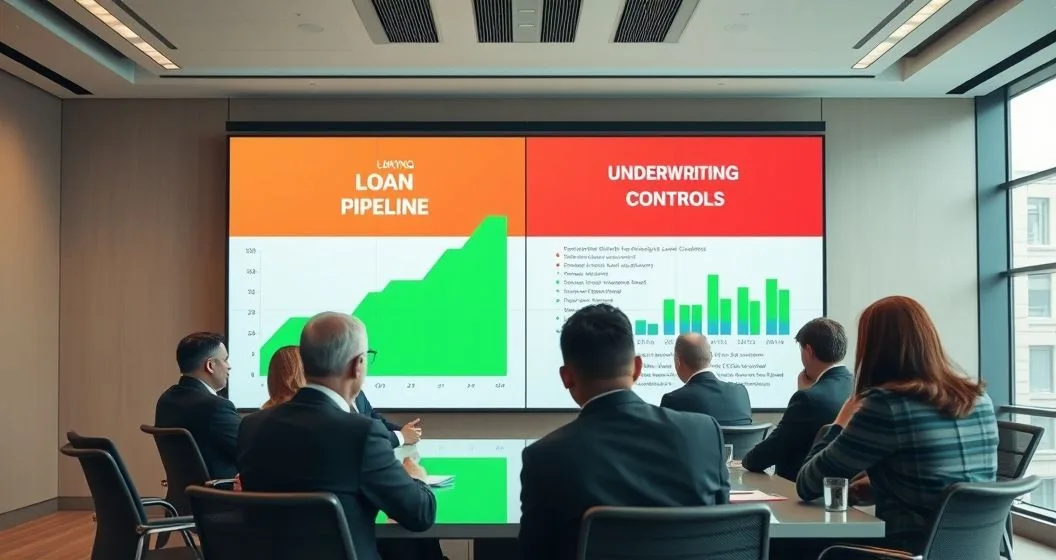How lender appetite shifts by cycle
Lenders change how and to whom they lend depending on where the economy sits in the cycle.
- Expansion (boom): Banks and nonbank lenders generally relax underwriting, increase credit lines, and compete for customers. That can mean lower spreads, higher loan-to-value allowances, and more willingness to finance riskier borrowers.
- Peak/late cycle: Appetite can remain elevated but becomes sensitive to signs of overheating (rising delinquencies, asset bubbles). Some lenders tighten selectively to protect capital.
- Contraction (recession): Underwriting standards tighten, credit supply shrinks, interest-rate spreads widen, and lenders raise documentation hurdles. Portfolio risk limits and higher reserves reduce new loan volume.
- Recovery: As delinquencies fall and capital cushions rebuild, lenders gradually expand credit again, often starting with prime borrowers.
These dynamics are driven by interest-rate policy, capital rules, market funding costs, and lender profitability. Federal Reserve policy and bank stress testing influence how much risk banks can carry (Federal Reserve). Consumer protection and enforcement environments also shape products and underwriting (Consumer Financial Protection Bureau).
Main drivers of lender appetite
- Credit performance: Rising defaults push lenders to tighten; improving performance permits loosening.
- Funding and liquidity costs: When wholesale funding spikes, lenders reduce risky or long-duration lending.
- Capital and regulatory pressure: Higher capital requirements or stress-test results reduce risk appetite.
- Profit motives and competition: Strong competition and stable margins encourage looser standards.
- Macro indicators: Unemployment, inflation, and consumer confidence inform credit models and board decisions.
In practice: during the 2020 pandemic I saw lenders abruptly raise credit-score and documentation requirements, then loosen for prime borrowers as markets stabilized. These moves reflected both risk and operational capacity constraints (e.g., remote verification).
Who feels the change
Almost everyone who borrows can be affected:
- Mortgage and auto buyers may face higher down payments or tighter credit overlays in downturns.
- Small businesses typically see reduced term‑loan approvals and shorter maturities when appetites fall.
- Credit-card and consumer-lending offers often shrink or carry higher rates when lenders pull back.
Small-business owners should watch bank appetite for specific sectors; industries hit hardest by a downturn (travel, restaurants) often see the steepest pullback.
Practical strategies for borrowers and small businesses
- Strengthen credit profiles: Pay down high‑interest revolving debt and correct errors on credit reports (see related guidance on loan shopping and credit impact: Loan Shopping Strategy: Minimizing Credit Score Impact — https://finhelp.io/glossary/loan-shopping-strategy-minimizing-credit-score-impact/).
- Build documentation and cash buffers: Lenders ask for stronger income verification and liquidity proof during tight cycles.
- Consider alternative underwriting or lenders: Some community banks and fintechs use cash‑flow or alternative data (Alternative Underwriting: Using Cash Flow Instead of Credit Scores — https://finhelp.io/glossary/alternative-underwriting-using-cash-flow-instead-of-credit-scores/).
- Time large financings: If possible, lock rates or delay non-urgent borrowing until indicators improve.
- Diversify funding: Businesses can combine lines of credit, invoice financing, or SBA options to reduce reliance on one lender.
Common mistakes to avoid
- Assuming all lenders act the same: Appetite varies by institution, product, and risk tolerance.
- Waiting until a crisis: Proactive credit improvement and documentation make approvals faster when markets tighten.
- Overrelying on advertised rates: During downturns, lenders layer overlays that raise effective costs.
Quick checklist before applying for credit
- Check and correct your credit reports.
- Prepare 12–24 months of income and expense documentation.
- Reduce revolving balances where feasible.
- Engage lenders early to understand current overlays and timing.
Internal resources
- For mortgage-specific risk factors and lender requirements, see Jumbo Mortgage Requirements: What Lenders Look For Beyond Credit Scores — https://finhelp.io/glossary/jumbo-mortgage-requirements-what-lenders-look-for-beyond-credit-scores/.
- For small‑business credit steps, review Business Credit Scores: What Lenders Look For in SMBs — https://finhelp.io/glossary/business-credit-scores-what-lenders-look-for-in-smbs/.
Sources and professional note
This entry synthesizes industry practice and public sources. Key references: Federal Reserve (policy and bank condition reports) and Consumer Financial Protection Bureau (consumer lending guidance) (https://www.federalreserve.gov/, https://www.consumerfinance.gov/). In my work advising borrowers across cycles, the most reliable wins come from early preparation and by matching borrower profile to the lenders most likely to finance that risk.
Professional disclaimer: This content is educational and not personalized financial advice. For tailored recommendations, consult a licensed financial advisor or lender.



